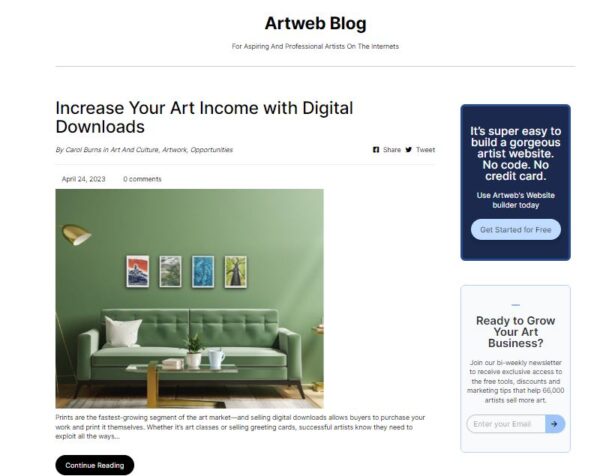Having a well-crafted artist blog on your website is how visitors get to know you. If your blog ranks well in search results, it’s often how potential buyers find you in the first place.
The first step to creating an art blog is considering its purpose. Do you want to:
- Attract readers.
- Attract customers (and sales).
- Attract subscribers and followers.
Chances are you want a bit of all three. Attracting readers helps create customers and followers.
What is an art blog?
Exclusive to the web, a blog is generally an opinion-based piece of writing. Although there may be facts buried in there, unlike journalism there is no fact-checking before clicking publish. These web-based musings have created hundreds of superstars, and we can learn from what they did right. The most popular blogs seamlessly combine the personality of the writer with the subject, whether it’s art, fashion or celebrity.
The best art blogs are informative, but they are also about the artist. Think of third person versus first person in a novel. Write “How I did it” not “how to do it” (show, don’t tell).
And you don’t have to call it a blog. Other names for this section of your art site can be labeled “News”, “Features”, or simply “Latest”.
Note that most readers will visit one of your blog pages from a search engine result. So while you want to take time to curate a blog homepage, it may not be the first thing they see.

How many artist blog posts should I do a month?
This is a matter of quality, not quantity. Choose a number of blog articles you can reasonably produce in given timeframe. One a month, two a month, or even one per season is acceptable.
If you’re just starting out with no or few followers, publishing one or several articles a week may not add value to your business and can take away from your studio time. Decide how many quality posts you can do each month. Putting out poorly written blogs can lose you readers.
Length of artist blog article
For print, there is a set word count for writer’s to work within. Online there is nothing to tame you. But unless you are tackling a complex subject, your blog articles should be around 400 to 1000 words (this one is around 900).
Remember that good blogs are easy to read and informative. You want a reader to go away and say to someone “I just read on the internet that…” about your post. Consider your unique perspective and wisdom you can impart with your audience, and break that down into short, focused blog posts.
Using images on your art blog
Visual elements are especially important for an art blog. For reviews, use images of the artwork you are talking about.
TIP: Read our guide on how to take high-quality photos of your artwork.
Good habits with images on your artist blog
- Image size: make sure all images are the same size and sit the same on a page.
- Images need to be fully credited. If someone is supplying you with images, ask for the credit details.
- Sign up for free stock image websites and check out Wiki images for free-to-use photos of artworks, but always carefully check permissions. Never use images you find from a search engine if you are unsure about the copyright status.

Laying out your art blog
A long stream of text can look like a lot of effort to get through. This is where white space comes in. This part of the page has nothing on it: no text, images, or pattern. In printed magazines, this space signifies luxury. The great thing about a website is that it doesn’t cost you anything to print. This means you can use larger text with lots of headings and images.
TIP: Look at your blog page as a single visual. Does it look good? Or does it look cluttered and overwhelming?
Artist blog ideas
Review exhibitions or events
An artist should be embedded in the art world locally, nationally, or globally. This means attending exhibitions, open events, and even lectures. All this should give you plenty to write about.
A review should focus on your thoughts on the exhibition or event but also include some basic information, including
- The venue.
- The dates of the exhibition.
- The name of the exhibition.
- The name of the artists taking part.
- A brief biography of the artist.
TIP: Stick to positive reviews and always spell the artist’s name and any artwork correctly.
Once you’ve covered the basics, it’s time for some opinions! Some of the things you might want to include in any write-up:
- Favorite works, explain why it appeals to you.
- How the work makes you feel.
- How well it works in the venue/curation.
- Include a few quotes from the artist’s statement.
TIP: Ask the artists featured to include your review on their website with a link to your blog. This is called a backlink and is good for SEO (search engine optimization). Having good SEO helps your blog rank higher in search engine results.
Share your latest works and works in progress
- Whet appetites with new work you have created or tell a visual story of a piece being made.
- Consider sharing your work process with images. “This work began with a simple sketch while walking…”
- The inspiration and choices: “The approach to creating the work is”, “I like to walk along my local beach before creating work…”
- Include images of other works in the series. “This work sits with others I’ve created in the theme of…”
Provide expertise
Use your expertise to craft “how to” guides for your readers. This might be how to make a canvas or how to mix red paint.
If you are a crafter, you could “how to” an element of your craft. For example, how to make a lampshade or a simple piece of jewelry. This type of post should have images to go along with each step.
TIP: Think about how you will illustrate or use photographs in your blog before you start writing.
Comment on trends
This might be an easier one for craftspeople and makers. Connecting your work with things on-trend can help draw people into your blog as they become trending items on search engines.
If you are working with materials or styles that suddenly find themselves the center of attention, make the most of it!
- Identify yourself as a user or practitioner.
- Acknowledge the interest it is attracting.
- Discuss why and how you use it and its attraction and appeal.
- Show your work.
TIP: Get your facts right! Always do a bit of research if you are commenting on anything.
Create evergreen content
It’s a good idea to have content that stays relevant and readable beyond a few days, or even weeks. This is known as evergreen content. So when thinking up subjects, ask yourself: Will this be relevant in six months? Is there anyway to extent its shelf life? If not, can you update content so it stays up to date?
Sign up to organizations offering small business blogs and newsletters with free expert tips and advice to inspire regular content.






